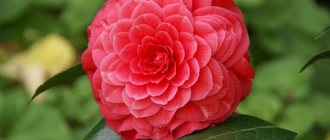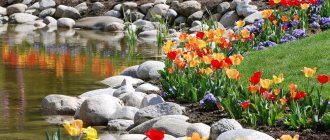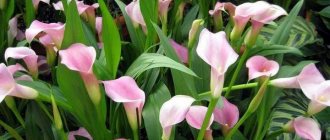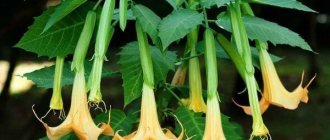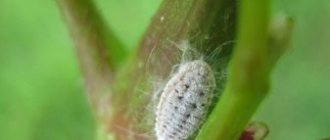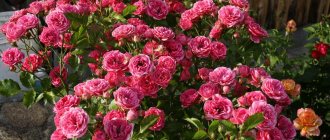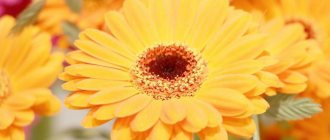The Brugmansia plant belongs to the Solanaceae family. An inexperienced gardener can easily confuse it with dope, since they look very similar to each other. However, the difference between these plants is significant: Brugmansia is represented by trees and shrubs, and Datura is a herbaceous plant.
Brugmansia is also popularly called “angel’s trumpet” or “golden dope”. This is due to the fact that during flowering, unusual flowers are formed on the plant that look like gramophones.
In the homeland of Brugmansia, this plant is widely used by aborigines to treat a large number of diseases. However, representatives of traditional medicine claim that the use of this plant for medicinal purposes can cause very dangerous side effects.
Brief description of cultivation
- Landing . Seeds are sown for seedlings between January and March. Transplantation of seedlings into open ground is carried out in the first summer weeks.
- Bloom . Starts in July and ends in December.
- Illumination . Needs a lot of bright light.
- Soil . Moist, well permeable to air and water, slightly alkaline or neutral.
- Temperature . In the warm season it grows well at any temperature. In winter, the bush is brought into a cool (from 8 to 12 degrees) room.
- Watering . In open ground, water abundantly, and in winter, indoors - moderately.
- Air humidity . Needs to moisten the foliage with a spray bottle.
- Fertilizer . Fertilizing is carried out in May–August once every 7 days, and a complex mineral fertilizer is used for this. In winter, fertilizers are not applied to the soil.
- Transplant . It is carried out in the autumn, before the onset of the first frost.
- Trimming . It is held from March 1 to March 15.
- Reproduction . By cuttings and seed method.
- Pests . Red spider mites, caterpillars, whiteflies and slugs.
- Diseases . Gray rot.
- Properties . Brugmansia contains alkaloids that are very poisonous, for example, atropine.
Brugmansia in the flower garden. Care, reproduction, diseases, pests.
What kind of flower is Brugmansia, and what is its peculiarity?
Brugmansia is a tree-like plant of the nightshade family. The main facts that you should be aware of before you start growing this flower:
- It has a very long flowering period - up to five months.
- Brugmansia loves warmth, so it is best to plant it in a pot and take it outside when the threat of frost has passed.
- It can grow both in a container and in open ground, but sowing immediately in a permanent place is not encouraged.
- The average height of an adult plant is about 2 m. But there are varieties that can reach 5 m!
Features of Brugmansia
Brugmansia is a member of the genus of the Solanaceae family. Previously, this plant belonged to the genus Datura (Datura), because its representatives bloom in the same way as Brugmansia. The genus Brugmansia includes 6 species, which are represented by compact trees and evergreen shrubs. Under natural conditions, the plant can be found in South America, where it grows in the subtropical foothills. It was named after Sebald Justinus Brugmans, a Dutch botanist.
This plant is distinguished by its heat-loving nature, so it is quite difficult to cultivate it in mid-latitudes. However, many gardeners still decide to grow Brugmansia in order to see its magnificent blooms and breathe in the aroma of unusual fragrant flowers.
Please note that Brugmansia tree can reach a height of 5 m or even more. Therefore, if your garden is small, then it is recommended to use compact varieties to decorate it, for example: Cordata Red, Culebra. Large oval, entire leaf blades have a wavy edge and pronounced veins. Their length is about 0.5 m. The peculiarity of this plant is that its foliage grows in two tiers: the first tier includes leaf plates with a solid, smooth edge, having an elongated shape, and the second includes more compact leaves, the edges of which embossed. The fragrant flowers have a bell-tubular shape, and they are incredibly large: length is about 0.5 m, and in diameter they reach up to 0.2 m.
There are varieties with both simple and double flowers. There are also varieties with two-tiered flowers. Flowers can be painted in various shades: yellow, peach, red, green, pink, orange, cream. There are also varieties with two-color and three-color flowers. It is interesting that flowers of different colors can bloom on one bush.
In mid-latitudes, this plant is grown as a tub crop. The bush is planted in a large pot. In the warm season, Brugmansia is in the garden, and it spends the winter months in a cool room.
Brugmansia - a magical flower
After reading the title, you might think that we are now going to discuss magical rituals. Or rather, the recipe to prepare the desired infusion. Actually, there is some truth in this - you will get acquainted with a flower that is still actively used in their practice by magicians, shamans and other specialists in working with otherworldly energies. Its name is Brugmansia. Its close relative is very familiar to all of us - this is Datura. For some time, Brugmansia was also called Datura, but recently it was separated into a separate branch of the Solanaceae family.
Its pleasant aroma, similar to oriental lilies, gives the composition elusive sophistication and charm. If you actually saw this flower with your own eyes, the aroma will sound especially beautiful, because it is difficult to convey its extraordinary music in words.

This is one of the reasons why the flower is called "angel's trumpet". Adding to the wonderful smell is the original shape of the flower, which resembles a wind instrument. Looking and “listening” to Brugmansia, an association with the intervention of higher powers comes to mind.
Ulrika
Brugmansia is a flower with a special life rhythm. For example, during the day it does not smell too much. In addition, in the heat of the day, the petals close, retaining moisture. But at night you will hear a very strong and exciting aroma. But especially sensitive people are not recommended to stay near Brugmansia for a long time - it can lead to headaches.
By the way, for the same reason it is better to grow Brugmansia in the garden or in well-ventilated areas. Keep in mind that the seeds and flowers are poisonous.
There is even a legend about the intense impact of its smell, which was told to us in Sweden, in Stockholm. There is the Ulriksdal Castle Museum, on the territory of which there is a flower greenhouse.
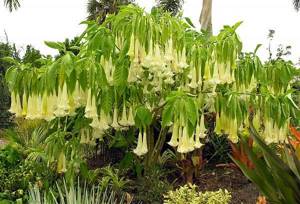
This happened several centuries ago. Once upon a time there lived a cruel and capricious Baron Jacob, who went through more than one battle. And one day he brought with him another trophy - his young wife. Moreover, the trophy turned out to be so “successful” that his wife was able to influence Jacob for the better - he was no longer eager to fight, but preferred a settled life in the castle.
They had a daughter, but the young wife soon died, and Jacob became a widower. His only joy was his daughter, Ulrika. When she grew up, Jacob decided to build her a beautiful castle. To do this, he invited an overseas architect. When the castle was built, Ulrika admitted to Jacob that she loved the architect and wanted to marry him so that she could travel around the world. For the baron, this was a blow, because parting with his daughter meant being left completely alone.
Then he resorted to a trick. The young couple were supposed to separate for 5 years, and after this period the architect was supposed to return, and then Jacob would personally marry them in the chapel at the castle.
The architect built a greenhouse with overseas flowers especially for Ulrika. Before leaving, he brought her there and told her to take care of them personally - then time would fly by quickly.
And so 5 years passed, 10, 15, but the architect never returned. Many wooed Ulrika, but she refused everyone - the baron did not want to force her into marriage. Soon Jacob was gone, and Ulrika was left alone. Her favorite place was still the greenhouse. And so on one of her birthdays, she asked the servants to bring a chair, wine and music. The servants dissuaded her from this step, because the smell of flowers in a closed room is harmful, but she insisted on her own.
In the morning, Ulrika was found in a chair with a happy smile on her lips, gone into another world. In memory of her and her love, the descendants preserved the greenhouse and the church. Getting married here is considered a good sign.

Devil tree
Well, well, surprisingly, Brugmansia also has such a name. Agree that the resonance in the names is quite strong. What is the reason? The flower contains components that, when used in a certain way, cause hallucinations of targeted action. For example, a person sees the spirits of the jungle and rivers. Who knows, perhaps Brugmansia really opens the way to the invisible world.
In one of the tribes, Brugmansia is called the “flower of power.” After all, the flower also has a healing effect - as usual, the main thing is to follow the dosage. Burns, coughs, asthma and much more can be “fixed” with Brugmansia. As often happens in nature, the same plant acts as a medicine, poison and antidote at the same time.
Hence, Brugmansia has earned the “pseudonym” - witchcraft grass or sorcerer’s grass. In addition, energetically, it helps clear space of negative energy and protects against night terrors.

The calming, intoxicating and enveloping sound of Brugmansia can be found in the following compositions:
Lancome, Poeme
Benetton, Benetton White Night Woman
Nina Ricci, Ricci Ricci
Alta Moda, Dreams
And here is the legend of the Zuni tribe about the ancestors of the Solanaceae family. A long time ago, twin brothers, the sons of the Sun, ruled everything on the planet.
One day they learned that under the Earth one of the goddesses gave birth to twins - a brother and a sister. The Sons of the Sun “took them under control” because the brother and sister began to climb to the surface. They were curious to learn about the world around them, every evening at home they told their mother about different phenomena.
Brother and sister were careful not to harm anyone or break anything. As time passed, the solar twins realized that brother and sister had become accustomed to the surface very well. So they decided to find out how far things had gone.
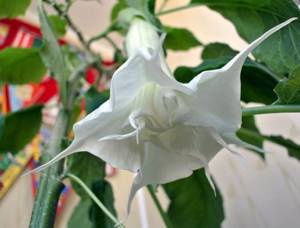
The brothers found out from their brother and sister that they make people happy with the help of special flowers that they put at their head at night. Their aroma gives people happy, prophetic dreams.
Then the solar brothers decided that the power of brother and sister over people was growing, so they forbade them to appear on the surface in the future. They sealed the only way out. But after some time, the same flowers that the brother and sister gave to people grew in its place - and it was dope.
As you can see, Brugmansia is a sign that invisible forces are always there to help us. The main thing is to carefully watch the signs...
Growing Brugmansia from seeds
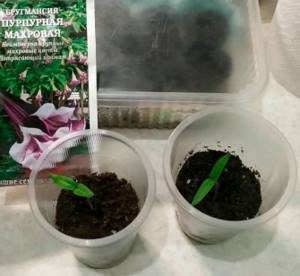
Sowing seeds
Brugmansia can be propagated in two ways: vegetatively and seeds (generative). If you decide to use the seed propagation method, then sowing the seeds should be carried out in January–March. To do this, fill a small box with a light soil mixture and bury the seeds 5–10 mm into it. When sowing is completed, moisten the substrate with a spray bottle. The top of the box is covered with transparent glass or film, then it is transferred to a warm (20 to 25 degrees) place with diffused bright lighting. The time of emergence of seedlings depends on the freshness of the seed. So, seedlings can appear after either 10 or 50 days.
Pre-sowing preparation of Brugmansia seeds.02/17/2019
Seedlings
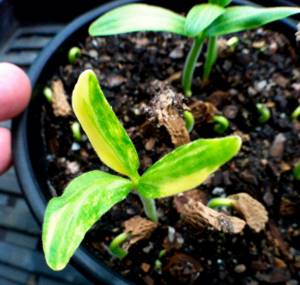
After the first seedlings appear, the cover is removed from the box. Moisten the crops regularly twice or thrice a day with warm water from a spray bottle, but make sure that there is no excess moisture in the substrate. After the fifth leaf blade has formed on the seedlings, they should be picked into individual cups or small pots. Remember that a plant grown from seed does not always retain the varietal characteristics of the parent bush. That is why gardeners prefer to propagate Brugmansia by cuttings, and this method is also distinguished by its ease and speed.
Transplanting into a permanent pot

After the root system of the seedling has entwined the entire lump of earth in the cup, it should be transplanted into a permanent container. The substrate should be nutritious and light, for example: humus (compost), loam and peat (1:1:2). Mix everything well, and then pour the soil mixture with a pinkish solution of potassium manganese.
The bush is replanted using the transshipment method. To do this, it, together with the earthen lump, is carefully pulled out of the old pot and planted in a new, larger container, at the bottom of which a good drainage layer should be made. The bush can also be planted in open ground. But no matter how you cover it, it will still freeze in winter. In this regard, gardeners grow it as a tub plant.
Growing from seeds
Seeds that are too dense must be soaked in warm water for a day, it is advisable to add a little root formation stimulator. Before soaking, lightly scratch the seed to break the integrity of the seed cover, germination will occur faster.

For planting, take garden soil, it is light and neutral. The seed is placed in the ground to a depth of no more than a centimeter.
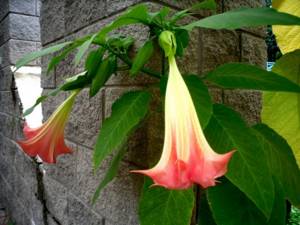
An important condition for the emergence of seedlings is humidity and warmth, so create greenhouse conditions with a temperature within 28⁰C. Seeds are sown from January to March.
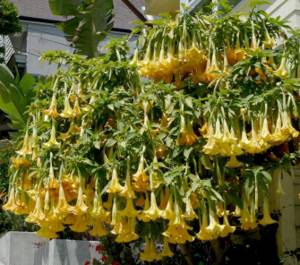
A month later, with the appearance of the first shoots, the main requirement must be met - good lighting. With this method of propagation, Brugmansia will bloom in 2-3 years of life. You will have to replant the flower several times in the first year as the root system grows.
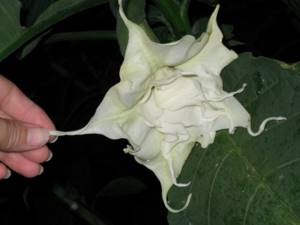
The plant is replanted in early spring. Often limited to changing the top layer of soil. Use drainage, it will protect the roots from rotting.
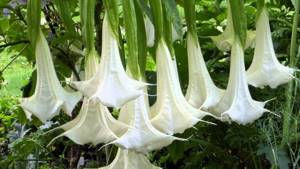
Brugmansia care
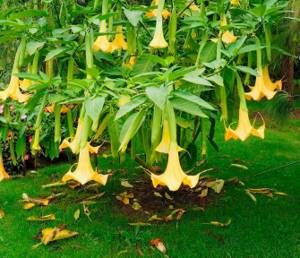
There is an opinion that Brugmansia is very demanding in terms of care and growing conditions. However, this is not the case. Caring for the plant is quite simple, but you still need to take several features into account.
Selecting a location
For Brugmansia, choose a well-lit place in the garden that will be shaded during the midday hours. It must also be protected from drafts. On hot days, it is recommended to sometimes moisten the foliage with a spray bottle; spraying is carried out in the evening. During the hot, dry period, the substrate in the pot is moistened every day. During rainy and cloudy periods, watering is carried out only after the surface of the soil mixture has dried.
Feeding

The plant needs regular feeding. They are carried out once a week, and a mineral complex is used for this. After the flowers bloom on the bush, additional phosphorus and potassium must be added to the soil mixture.
Trimming

The plant needs annual pruning, which is carried out in the first half of March. Cut out all injured and diseased branches; the remaining shoots should be shortened. Please note that the Y-shaped stems should not be pruned, as these are where the flowers will form in the future.
After flowering
In order to protect the plant from early frosts, it is brought indoors in early autumn. You can understand that it’s time to move Brugmansia from the garden to “winter” into the house by the following sign: the temperature at night began to drop to 5–7 degrees.
The bush feels good indoors, and its flowering can last until January (or even longer). It also happens that Brugmansia does not begin a dormant period at all, and it blooms constantly. If you want the plant to bloom profusely next season, then you will have to “force” it to “rest”. To do this, you will need to create suitable conditions: move the bush to a spacious, cool room, reduce the frequency and abundance of watering, and also stop feeding.
Wintering
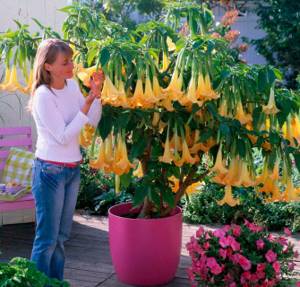
To prevent this crop from dying in winter, it is brought into a warm room and placed near a window. Water, moisten and feed the bush in the same way as in summer. Provide the plant with additional light in the evening. If everything is done correctly, the plant will delight you with its lush flowering for a long time.
If your house does not have enough space for such a large plant, then it can be placed in a dry and dark basement, and the air temperature should be from 5 to 8 degrees. Water the bush very rarely, but do not allow the earthen clod to dry out completely. As a rule, all the leaves of the bush fall off. However, in the last days of winter, buds will begin to open on its branches. At this time, it should be moved to a well-lit place.
Important! The warmer the room where Brugmansia overwinters, the more light it needs.
All about Brugmansia in brief!
Houseplant care
It is necessary to take into account some facts of its development:
- it is very thermophilic;
- reacts to temperature changes, and can shed the crown and stop the development of buds;
- acceptable temperature 23⁰С - 28⁰С;
- At around zero degrees, vegetation stops, and then the trunk may die.
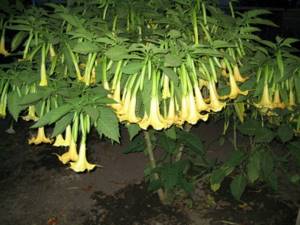
Therefore, you need to fulfill the necessary requirements regarding caring for the plant indoors:
- maintain a temperature that suits the growth and development of the flower;
- avoid drafts;
- maintain moisture levels;
- follow the feeding rules;
- trim the crown as necessary;
- replant the plant in time.

In summer, it is permissible and even necessary to take the pot of Brugmansia out into the fresh air, taking all precautions.
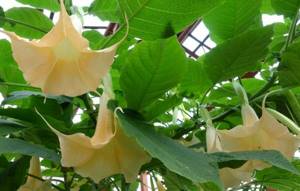
If you ate a flower in your apartment all year round, but there is not enough light, don’t skimp on additional lighting. In winter, when coolness is required (within 10 degrees), light is not needed.
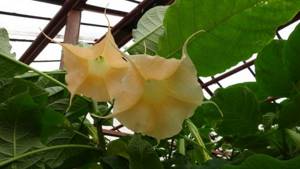
Propagation of Brugmansia by cuttings

In order to propagate Brugmansia, you can use the cutting method. For cutting cuttings, select annual branches with a length of 15 to 25 centimeters. They must have an apical growth point, since such segments take root and bloom faster.
Harvesting and rooting of cuttings is carried out in the last spring or in the first summer weeks. All the lower leaf plates of the segment are torn off, then it is placed in a container with water, to which activated carbon is added. Place the cutting in a well-lit and warm (at least 20 degrees) place. To prevent the foliage from wilting, it is regularly moistened with cold water. The top of the cutting should be covered with a glass jar or a cut plastic bottle.
The roots should grow in 14 days. After they reach 50 mm in length, the piece is planted in a small pot, using an earth mixture consisting of perlite, peat and sand (1:2:1). Complete rooting will occur after 15–20 days.
BRUGMANSIA//My many years of experience in propagation by cuttings, planting, transplanting and preserving in winter.
Types of Brugmansia with photos and names
It was already mentioned above that there are only 6 species of Brugmansia.
Golden Brugmansia (Brugmansia aurea)
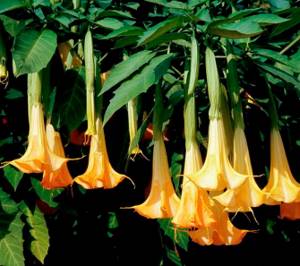
Under natural conditions, the height of the plant can reach up to 6 m. There is pubescence on the surface of the soft leaf plates. With a wide limb, the flowers are painted in various shades of yellow.
Brugmansia suaveolens
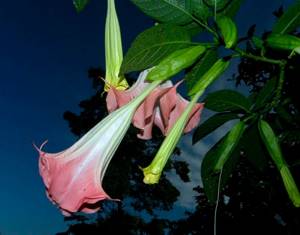
The species is distinguished by its very fast growth and strong branching. White fragrant flowers are decorated with green veins. However, in buds the flowers are pink in color.
Brugmansia candida

A compact, low tree with low-growing stems. The pubescent leaf blades are oval in shape. The flowers are white, but there are varieties with yellow and apricot colors.
Brugmansia sanguinea
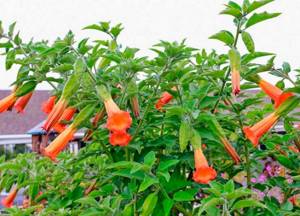
The height of the plant is about 12 m. The rich orange flowers are decorated with a fiery red border and yellow veins. This species differs from others in its greatest resistance to cold. But it also needs to be moved indoors for the winter.
